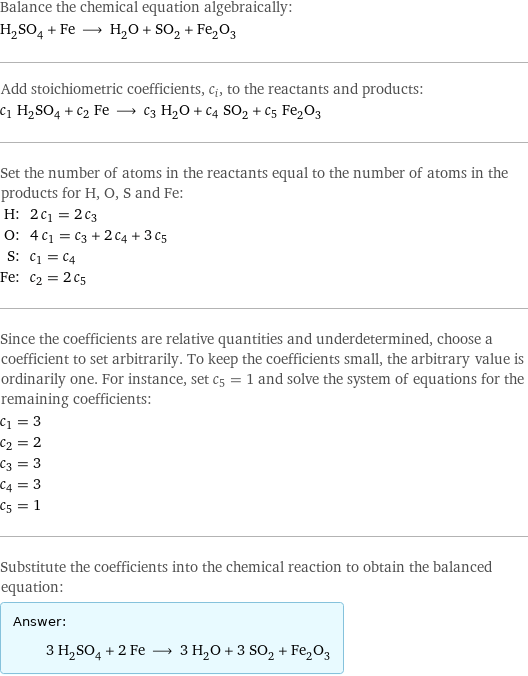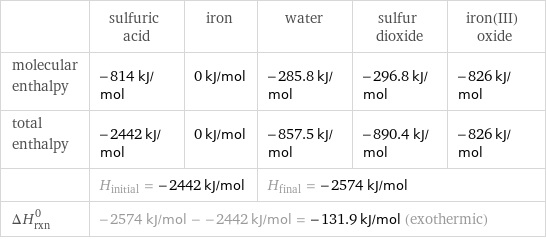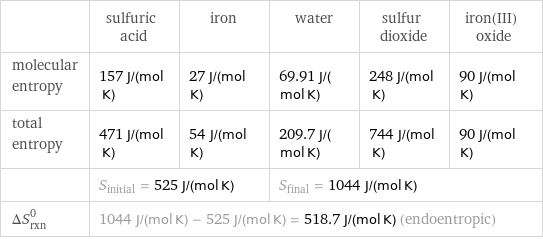Input interpretation

H_2SO_4 sulfuric acid + Fe iron ⟶ H_2O water + SO_2 sulfur dioxide + Fe_2O_3 iron(III) oxide
Balanced equation

Balance the chemical equation algebraically: H_2SO_4 + Fe ⟶ H_2O + SO_2 + Fe_2O_3 Add stoichiometric coefficients, c_i, to the reactants and products: c_1 H_2SO_4 + c_2 Fe ⟶ c_3 H_2O + c_4 SO_2 + c_5 Fe_2O_3 Set the number of atoms in the reactants equal to the number of atoms in the products for H, O, S and Fe: H: | 2 c_1 = 2 c_3 O: | 4 c_1 = c_3 + 2 c_4 + 3 c_5 S: | c_1 = c_4 Fe: | c_2 = 2 c_5 Since the coefficients are relative quantities and underdetermined, choose a coefficient to set arbitrarily. To keep the coefficients small, the arbitrary value is ordinarily one. For instance, set c_5 = 1 and solve the system of equations for the remaining coefficients: c_1 = 3 c_2 = 2 c_3 = 3 c_4 = 3 c_5 = 1 Substitute the coefficients into the chemical reaction to obtain the balanced equation: Answer: | | 3 H_2SO_4 + 2 Fe ⟶ 3 H_2O + 3 SO_2 + Fe_2O_3
Structures

+ ⟶ + +
Names

sulfuric acid + iron ⟶ water + sulfur dioxide + iron(III) oxide
Reaction thermodynamics
Enthalpy

| sulfuric acid | iron | water | sulfur dioxide | iron(III) oxide molecular enthalpy | -814 kJ/mol | 0 kJ/mol | -285.8 kJ/mol | -296.8 kJ/mol | -826 kJ/mol total enthalpy | -2442 kJ/mol | 0 kJ/mol | -857.5 kJ/mol | -890.4 kJ/mol | -826 kJ/mol | H_initial = -2442 kJ/mol | | H_final = -2574 kJ/mol | | ΔH_rxn^0 | -2574 kJ/mol - -2442 kJ/mol = -131.9 kJ/mol (exothermic) | | | |
Entropy

| sulfuric acid | iron | water | sulfur dioxide | iron(III) oxide molecular entropy | 157 J/(mol K) | 27 J/(mol K) | 69.91 J/(mol K) | 248 J/(mol K) | 90 J/(mol K) total entropy | 471 J/(mol K) | 54 J/(mol K) | 209.7 J/(mol K) | 744 J/(mol K) | 90 J/(mol K) | S_initial = 525 J/(mol K) | | S_final = 1044 J/(mol K) | | ΔS_rxn^0 | 1044 J/(mol K) - 525 J/(mol K) = 518.7 J/(mol K) (endoentropic) | | | |
Equilibrium constant
![Construct the equilibrium constant, K, expression for: H_2SO_4 + Fe ⟶ H_2O + SO_2 + Fe_2O_3 Plan: • Balance the chemical equation. • Determine the stoichiometric numbers. • Assemble the activity expression for each chemical species. • Use the activity expressions to build the equilibrium constant expression. Write the balanced chemical equation: 3 H_2SO_4 + 2 Fe ⟶ 3 H_2O + 3 SO_2 + Fe_2O_3 Assign stoichiometric numbers, ν_i, using the stoichiometric coefficients, c_i, from the balanced chemical equation in the following manner: ν_i = -c_i for reactants and ν_i = c_i for products: chemical species | c_i | ν_i H_2SO_4 | 3 | -3 Fe | 2 | -2 H_2O | 3 | 3 SO_2 | 3 | 3 Fe_2O_3 | 1 | 1 Assemble the activity expressions accounting for the state of matter and ν_i: chemical species | c_i | ν_i | activity expression H_2SO_4 | 3 | -3 | ([H2SO4])^(-3) Fe | 2 | -2 | ([Fe])^(-2) H_2O | 3 | 3 | ([H2O])^3 SO_2 | 3 | 3 | ([SO2])^3 Fe_2O_3 | 1 | 1 | [Fe2O3] The equilibrium constant symbol in the concentration basis is: K_c Mulitply the activity expressions to arrive at the K_c expression: Answer: | | K_c = ([H2SO4])^(-3) ([Fe])^(-2) ([H2O])^3 ([SO2])^3 [Fe2O3] = (([H2O])^3 ([SO2])^3 [Fe2O3])/(([H2SO4])^3 ([Fe])^2)](../image_source/d1dc49e450d50b557781f42dd802a570.png)
Construct the equilibrium constant, K, expression for: H_2SO_4 + Fe ⟶ H_2O + SO_2 + Fe_2O_3 Plan: • Balance the chemical equation. • Determine the stoichiometric numbers. • Assemble the activity expression for each chemical species. • Use the activity expressions to build the equilibrium constant expression. Write the balanced chemical equation: 3 H_2SO_4 + 2 Fe ⟶ 3 H_2O + 3 SO_2 + Fe_2O_3 Assign stoichiometric numbers, ν_i, using the stoichiometric coefficients, c_i, from the balanced chemical equation in the following manner: ν_i = -c_i for reactants and ν_i = c_i for products: chemical species | c_i | ν_i H_2SO_4 | 3 | -3 Fe | 2 | -2 H_2O | 3 | 3 SO_2 | 3 | 3 Fe_2O_3 | 1 | 1 Assemble the activity expressions accounting for the state of matter and ν_i: chemical species | c_i | ν_i | activity expression H_2SO_4 | 3 | -3 | ([H2SO4])^(-3) Fe | 2 | -2 | ([Fe])^(-2) H_2O | 3 | 3 | ([H2O])^3 SO_2 | 3 | 3 | ([SO2])^3 Fe_2O_3 | 1 | 1 | [Fe2O3] The equilibrium constant symbol in the concentration basis is: K_c Mulitply the activity expressions to arrive at the K_c expression: Answer: | | K_c = ([H2SO4])^(-3) ([Fe])^(-2) ([H2O])^3 ([SO2])^3 [Fe2O3] = (([H2O])^3 ([SO2])^3 [Fe2O3])/(([H2SO4])^3 ([Fe])^2)
Rate of reaction
![Construct the rate of reaction expression for: H_2SO_4 + Fe ⟶ H_2O + SO_2 + Fe_2O_3 Plan: • Balance the chemical equation. • Determine the stoichiometric numbers. • Assemble the rate term for each chemical species. • Write the rate of reaction expression. Write the balanced chemical equation: 3 H_2SO_4 + 2 Fe ⟶ 3 H_2O + 3 SO_2 + Fe_2O_3 Assign stoichiometric numbers, ν_i, using the stoichiometric coefficients, c_i, from the balanced chemical equation in the following manner: ν_i = -c_i for reactants and ν_i = c_i for products: chemical species | c_i | ν_i H_2SO_4 | 3 | -3 Fe | 2 | -2 H_2O | 3 | 3 SO_2 | 3 | 3 Fe_2O_3 | 1 | 1 The rate term for each chemical species, B_i, is 1/ν_i(Δ[B_i])/(Δt) where [B_i] is the amount concentration and t is time: chemical species | c_i | ν_i | rate term H_2SO_4 | 3 | -3 | -1/3 (Δ[H2SO4])/(Δt) Fe | 2 | -2 | -1/2 (Δ[Fe])/(Δt) H_2O | 3 | 3 | 1/3 (Δ[H2O])/(Δt) SO_2 | 3 | 3 | 1/3 (Δ[SO2])/(Δt) Fe_2O_3 | 1 | 1 | (Δ[Fe2O3])/(Δt) (for infinitesimal rate of change, replace Δ with d) Set the rate terms equal to each other to arrive at the rate expression: Answer: | | rate = -1/3 (Δ[H2SO4])/(Δt) = -1/2 (Δ[Fe])/(Δt) = 1/3 (Δ[H2O])/(Δt) = 1/3 (Δ[SO2])/(Δt) = (Δ[Fe2O3])/(Δt) (assuming constant volume and no accumulation of intermediates or side products)](../image_source/4e642db146bba3d5324a4fd4273c9f4e.png)
Construct the rate of reaction expression for: H_2SO_4 + Fe ⟶ H_2O + SO_2 + Fe_2O_3 Plan: • Balance the chemical equation. • Determine the stoichiometric numbers. • Assemble the rate term for each chemical species. • Write the rate of reaction expression. Write the balanced chemical equation: 3 H_2SO_4 + 2 Fe ⟶ 3 H_2O + 3 SO_2 + Fe_2O_3 Assign stoichiometric numbers, ν_i, using the stoichiometric coefficients, c_i, from the balanced chemical equation in the following manner: ν_i = -c_i for reactants and ν_i = c_i for products: chemical species | c_i | ν_i H_2SO_4 | 3 | -3 Fe | 2 | -2 H_2O | 3 | 3 SO_2 | 3 | 3 Fe_2O_3 | 1 | 1 The rate term for each chemical species, B_i, is 1/ν_i(Δ[B_i])/(Δt) where [B_i] is the amount concentration and t is time: chemical species | c_i | ν_i | rate term H_2SO_4 | 3 | -3 | -1/3 (Δ[H2SO4])/(Δt) Fe | 2 | -2 | -1/2 (Δ[Fe])/(Δt) H_2O | 3 | 3 | 1/3 (Δ[H2O])/(Δt) SO_2 | 3 | 3 | 1/3 (Δ[SO2])/(Δt) Fe_2O_3 | 1 | 1 | (Δ[Fe2O3])/(Δt) (for infinitesimal rate of change, replace Δ with d) Set the rate terms equal to each other to arrive at the rate expression: Answer: | | rate = -1/3 (Δ[H2SO4])/(Δt) = -1/2 (Δ[Fe])/(Δt) = 1/3 (Δ[H2O])/(Δt) = 1/3 (Δ[SO2])/(Δt) = (Δ[Fe2O3])/(Δt) (assuming constant volume and no accumulation of intermediates or side products)
Chemical names and formulas

| sulfuric acid | iron | water | sulfur dioxide | iron(III) oxide formula | H_2SO_4 | Fe | H_2O | SO_2 | Fe_2O_3 Hill formula | H_2O_4S | Fe | H_2O | O_2S | Fe_2O_3 name | sulfuric acid | iron | water | sulfur dioxide | iron(III) oxide